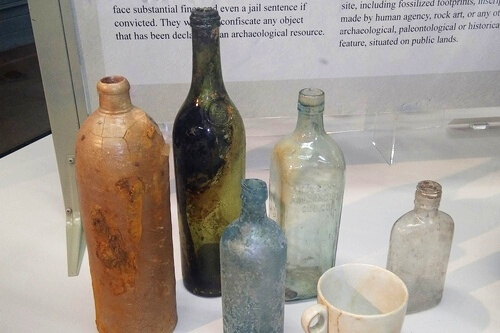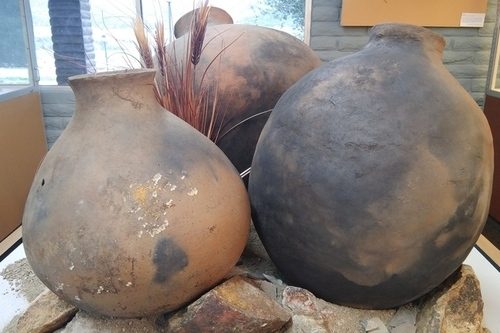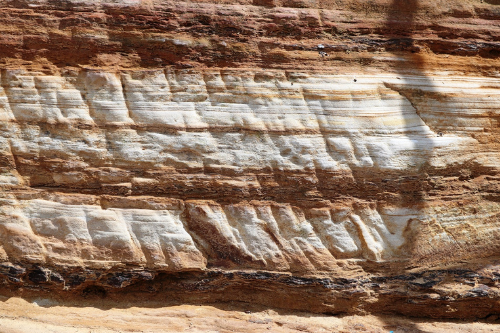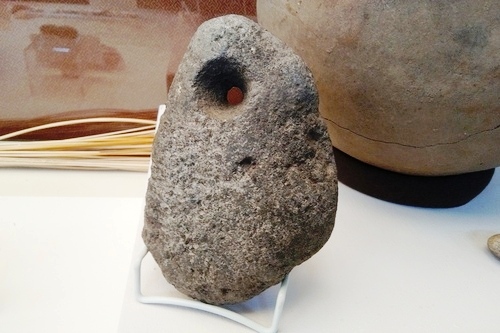
The Wonderful World of Stone Tool Technology
The Wonderful World of… is a monthly blog focusing on some of the many themes, concepts, and sub-disciplines related to the fascinating world of Southern Californian archaeology.
Introduction
Throughout human history, stone tools have been made by many different people, societies, and cultures. Before metal tools (which we are more familiar with today), stone was a popular raw material used for tool making and this occurred for more than three million years. This period (the Stone Age) lasted until the people in places like China, Europe, the Middle East, and Africa discovered how to utilize and manufacture metal implements. In the Americas, the Stone Age did not end until colonialism when European settlers invaded the area, bringing with them steel and iron tools. Stone tool technology is found all over what we now call San Diego County, with some tools dating back more than 10,000 years. These are the most common types of cultural resources found in the County at prehistoric sites. The Center preserves thousands of these types of tools to allow for research and access for the community and future generations to come.
Types of Stone Tools
 There are two generally recognized types of stone tools in this area: chipped stone and ground stone. They are named for their method of production. Chipped stone tools are made by the process of flintknapping. Brittle rocks like chert or obsidian are ideal for flintknapping. When they are struck by a harder rock, they fracture, chipping away flakes intentionally to create tools like projectile points or blades. Chipped stone tools were used for things like hunting, food preparation, cleaning animal hides, and for the construction of homes or shelters.
There are two generally recognized types of stone tools in this area: chipped stone and ground stone. They are named for their method of production. Chipped stone tools are made by the process of flintknapping. Brittle rocks like chert or obsidian are ideal for flintknapping. When they are struck by a harder rock, they fracture, chipping away flakes intentionally to create tools like projectile points or blades. Chipped stone tools were used for things like hunting, food preparation, cleaning animal hides, and for the construction of homes or shelters.
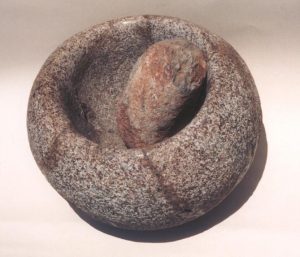 Ground stone tools are made by pecking, grinding, and polishing two stones together. Metamorphic rocks are ideal for making ground stone tools as the material is coarse. Manos and metates are two popular ground stone tools that are used to grind food like nuts and berries in the San Diego area. Ground stone tools were associated with grinding food and other substances such as color dyes. Weapons were also made from ground stone tools, attaching the stone to wood to make things like axes or clubs.
Ground stone tools are made by pecking, grinding, and polishing two stones together. Metamorphic rocks are ideal for making ground stone tools as the material is coarse. Manos and metates are two popular ground stone tools that are used to grind food like nuts and berries in the San Diego area. Ground stone tools were associated with grinding food and other substances such as color dyes. Weapons were also made from ground stone tools, attaching the stone to wood to make things like axes or clubs.
Material for Stone Tools
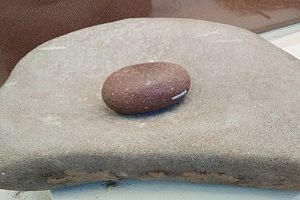
The material used to make tools changed depending on location and the types of rocks available to the maker. Some societies traveled to find specific types of rocks that would work best for the tool they were making. Typically, stronger stones like granitic rock were used to make ground stone tools, while glass-type rocks (like obsidian) work well for chipped stone tools. Indigenous communities would also trade materials as the geology in the area varies wildly with the different landscapes.
What is a Complex or Tradition?
Chipped and ground stone tool technologies developed with the changing traditions throughout the area, and their differences help archaeologists decipher when they were created. Many cultures learned, shared, and traded with one another, and tool making changed with time and the development of new innovations. Archaeologists can date many stone tools that are found at different sites based on each tool’s unique technologies and by using the chronological data and discoveries presented. These are referred to as a Complex or Tradition.
 These complexes or traditions (as we know them today) were developed over time beginning with research done by archaeologists Malcom J. Rodgers and Claude E. Warren in the 20th century, but this original data and typology grouped people and tools together which was problematic and limiting — and the data presented from this scope was at times inaccurate. Continuing off this research, local archaeologist and professor Dennis R. Gallegos created the above chart which is more inclusive and does not focus so much on grouping cultures with tools, but rather it creates a timeline for stone tool technology development giving more accurate data pertaining to when a tool was created and used. Learn more about Gallegos’ work, synthesizing more than 100 years of San Diego archaeology by reading First People: A Revised Chronology for San Diego County.
These complexes or traditions (as we know them today) were developed over time beginning with research done by archaeologists Malcom J. Rodgers and Claude E. Warren in the 20th century, but this original data and typology grouped people and tools together which was problematic and limiting — and the data presented from this scope was at times inaccurate. Continuing off this research, local archaeologist and professor Dennis R. Gallegos created the above chart which is more inclusive and does not focus so much on grouping cultures with tools, but rather it creates a timeline for stone tool technology development giving more accurate data pertaining to when a tool was created and used. Learn more about Gallegos’ work, synthesizing more than 100 years of San Diego archaeology by reading First People: A Revised Chronology for San Diego County.
Examples of Stone Tool Technology in San Diego
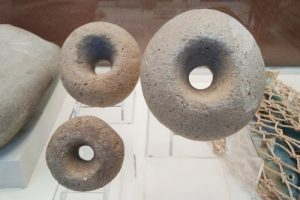
These are donut stone tools and while their exact use is unknown, archaeologists speculate that they were used as net sinkers or digging stick weights. These tools were finely crafted and required many hours of work.
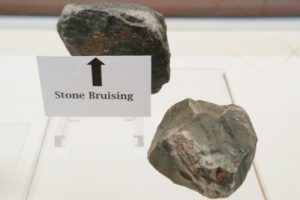
These are hammerstones and are useful in stone tool making because they are hard and fit nicely in the hand. Stone bruising develops when minerals in the stone are crushed after the hammerstone strikes another stone in tool creation. These stones date to the San Dieguito Complex/Tradition (10,000 – 7,500 years ago).
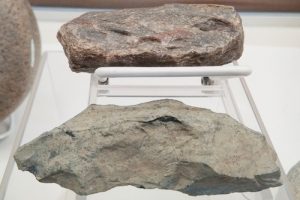
These are steeped-edge unifacial tools, sometimes called scrapers, and they are associated with the San Dieguito Complex/Tradition (10,000 – 7,500 years ago). These tools had many uses like skinning animals for food and hide production, for making spears, and for cutting.
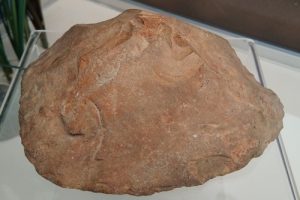 These types of tools were heavily utilized during the Middle Holocene, and useful for processing food like shellfish. Many of these Middle Holocene sites contain large shell middens, or garbage pits, where the shell waste was dumped away from inhabitants living quarters after consumption.
These types of tools were heavily utilized during the Middle Holocene, and useful for processing food like shellfish. Many of these Middle Holocene sites contain large shell middens, or garbage pits, where the shell waste was dumped away from inhabitants living quarters after consumption.
What Can Archaeologists Learn from Stone Tool Technology?
By examining stone tools found from different sites, archaeologists can determine whether these sites were once villages, hunting/gathering sites, ceremonial locations, or places used for the tool’s creation. Visit the California Department of Parks and Recreation to learn more about the types of archaeological sites in San Diego County State Parks.
Conclusion
Local stone tool technology was innovative and complex with many modern tools used today being modeled from this creativity and ingenuity.

If you look around your house, chances are you will find many tools similar to those created by Indigenous cultures thousands of years ago. A mortar and pestle are commonly used kitchen tools today – still often made from stone and used to grind a variety of things like spices, nuts, and seeds.’
Learn More
Visit us at the Center to learn more about stone tools and the different traditions/complexes in the area. We are currently open to the public by appointment, Thursdays and Fridays from 10 AM to 4 PM and Saturdays from 10 AM to 2 PM. Schedule your visit today!
by Jessica McPheters, Collections Manager


